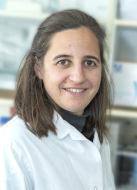
Mona Bensalah completed her thesis under the supervision of Elisa Negroni and Vincent Mouly in the team “Cellular and molecular orchestration in muscle regeneration, during aging and in pathologies” directed by Capucine Trollet and Vincent Mouly, at the Institute’s Myology Research Centre. Her work, completed by that of Laura Muraine, has just been published in the Journal of Cachexia Sarcopenia and Muscle*. It focuses on the cellular and molecular mechanisms that lead to fibrosis of the pharyngeal muscles, and more particularly on the role of non-myogenic human cells, called fibro-adipogenic progenitors (FAPs), in this process. Interview with Capucine Trollet.
What is the overall context of the project?
Fibrosis is defined as an excessive accumulation of extracellular matrix components and can affect many organs, including the lungs, liver, heart, skin, kidneys and muscles. Muscle fibrosis occurs in response to trauma, aging or myopathies and impairs muscle function. It represents a barrier to the treatment of human muscular dystrophies. Although data on the mechanisms involved have been studied mainly in mice, dystrophic mouse models often do not recapitulate fibrosis as seen in humans.
What were the objectives of this study?
In this study we were interested in the cellular and molecular mechanisms that lead to fibrosis in human muscle. We were particularly interested in the muscles of the pharynx. Indeed, dysphagia (swallowing disorder) is known to affect about 15-30% of elderly individuals and we have observed an increase in the connective tissue of the pharyngeal muscles in patients with oculopharyngeal muscular dystrophy (OPMD). We therefore investigated the role and nature of non-myogenic human cells, called fibro-adipogenic progenitors (FAPs) from fibrotic muscles (pharyngeal muscles) of healthy individuals and individuals with OPMD, compared to non-myogenic cells from non-fibrotic human muscles.
How did you proceed and what results did you obtain?
We combined mass cytometric analysis, transcriptomic analysis, in vitro co-culture experiments and in vivo transplantation into immunodeficient mice.
We found that FAPs from fibrotic muscles have very specific characteristics and have a negative role when co-cultured with muscle cells. In addition to the classical TGFβ profibrogenic pathway, we identified endothelin as a new player involved in altering the dialogue between muscle cells and fibrotic PAFs. Our data demonstrate the key role of PAFs and their communication with muscle cells via a paracrine signalling pathway in human skeletal muscle fibrosis.
What conclusions did you draw from this?
Our results indicate that muscle requires the coordinated and well-orchestrated interaction between muscle fibres and PAFs, and that any alteration in this interaction can disrupt overall muscle function, leading to the establishment of a pathological phenotype of PAFs.
What prospects does this study open up?
Our data suggest that endothelin blockade may represent a potential future strategy for treating muscle fibrosis, particularly in the pharyngeal muscles of patients with OPMD and achalasia, but also in other muscle diseases involving fibrosis. This is important because many recent innovative gene- or cell-based therapies have reduced efficacy due to the fibrotic nature of the targeted muscle.
